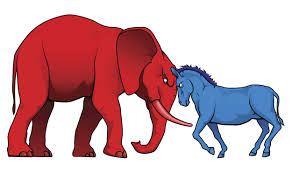Related Topics
Robert Morris and America
Robert Morris was an energetic problem-solver. In solving those problems he devised some innovative solutions which have become such axiomatic principles of a republic and its economics, that his name is seldom associated with them.
Robert Morris: The Dark Side
The richest man in America suddenly was locked in debtor's prison, $12 million in debt. While in prison, he reduced that to $3 million, and got released under a new bankruptcy law he helped devise.
Two-Party Ideologies

|
| Together |
Although they try to be subtle about it, the American political parties reverse their positions fairly often on issues. Indeed, there are several times when parties reversed positions with symmetry, each taking what was formerly the other party's position. For example, the Republican Party stood in defense of protective tariffs throughout the last half of the 19th century, while in the 21st century Democrats now take the pro-tariff position, and it is Republicans who hate it. If you look for the ideological center of the parties, it is not to be found in tariffs. Nor in taxes; the Federalists, effectively predecessors of the present Republican Party largely based their whole party on rewriting the Constitution to enable the Federal government to levy taxes. But more recently it might be fair to observe they allowed George Bush (41) to lose his 1992 presidential re-election campaign because he abandoned the "No new taxes" pledge. Twenty years later, the Tea Party is still on the warpath about holding taxes down. The difference between this Tea Party and the original (Boston)one is that now the Tea Party is in the hands of rock-ribbed conservatives instead of rowdy rebels.
On the question of how many parties to have, there is fairly uniform agreement that two is best. Third parties, or splinter parties, do appear from time to time but in retrospect can mostly be viewed as steps in repositioning one or both major parties. Our system of nomination depends on the utterly pragmatic question, "Can he win?", and cheerfully dumps some candidate the leadership really likes best if he seemingly can't win. The stability of our seemingly haphazard system emerges from two eventual choices, each chosen because shrewd analysts think they have the best chance with the public. The Constitution's authors hoped there would never be any political parties, but it is arguable that the remarkable stability of our government depends on them. More ideological leadership in other countries has led to many more political parties, each held by a tighter leash. The result has surprisingly been much less stability, because each splinter party is led by someone who imagines himself a Spartan at Thermopylae, determined to and usually successful at, dying for his cause. To those less cerebral about politics, one final pragmatic argument is offered: In our two-party system, the deals are made before the election, and the public is asked to choose between two best-effort products. In a multi-party system, the deals are made after the election, often requiring several efforts to get a workable coalition. And, having already voted, the public has surrendered its control over the composition of the deal.
Originally published: Friday, October 07, 2011; most-recently modified: Friday, June 07, 2019